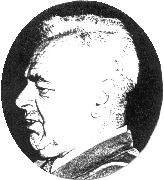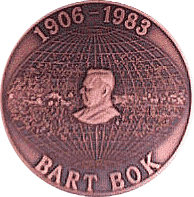
Bok Prize
Professor Bart Jan Bok was Director of Mount Stromlo Observatory from 1957 to 1966. He energetically promoted the undergraduate and graduate study of astronomy in Australia and set up the Graduate School of Astronomy at the Australian National University.
Bart shared a successful scientific collaboration with his wife, Dr Priscilla Bok. Together they also published the highly popular astronomy book The Milky Way. As a talented populariser of astronomy, Bart is particularly remembered for his entertaining broadcasts on ABC radio.

The Bok Prize is awarded annually by the Astronomical Society of Australia to recognise outstanding research in astronomy or a closely related field, by an Honours student or eligible Masters student at an Australian university.
The prize consists of the Bok Medal together with an award of $1,000 and ASA membership for the following calendar year. The recipient is invited to present a paper on their research at the Annual Scientific Meeting of the Astronomical Society of Australia, where the prize will be presented.
Nominations for the 2025 Bok Prize will open in December 2024 with a closing date of mid-February 2025.

Eligibility
- must have been an Honours student or eligible Masters student* at an Australian university in the previous calender year (ie. at 30 June in the year prior to the award).
- must have completed their degree requirements in the previous calendar year.
- must have been carried out research in an area of astronomy or closely related field.
* Eligible Masters students are those who have entered their Masters degree from a 3 year undergraduate degree. Students who completed an Honours year before entering the Masters degree are not eligible for the Bok prize.
Nominations
Nominations must adhere to the following guidelines:
- each Australian university can submit a maximum of two nominations per year (unless a special case can be made for an additional nomination).
- nominations must be endorsed by the Head of the nominee’s academic unit, in consultation with their academic staff. The Head should also certify that the applicant’s degree requirements have been completed during the previous calendar year.
- nominations must be submitted by the candidate’s supervisor.
- the nomination must include an electronic copy of the Honours/Masters thesis.
- the nomination must include a brief statement (~1/2 page) by the nominee, clearly describing their major contributions to the research, the resources they used and the help they received. This may already be included as part of the thesis.
- the nomination must also include a completed Supervisor’s Statement – this is a confidential statement by the nominee’s supervisor detailing the highlights of the research, indicating the relationship of the submission to the student’s course requirements, and highlighting the originality of the work. Please use the Supervisor’s Statement form (Word or pdf).
Nominations should be emailed to the ASA Prizes and Awards Coordinator, Dr Tanya Hill – thill@museum.vic.gov.au.
An assessment committee nominated by the ASA Council will evaluate the submitted materials and make a recommendation to the ASA Council. The decision of the ASA Council is final, including a decision not to award the prize in any given year.
Limited travel funds to support attendance at the ASA Annual Scientific Meeting may be made available at the discretion of the ASA Council.
Previous Winners
- 2024 – Sophie Young (University of Tasmania)
- Free-free Absorption in Young Radio Galaxies
- 2023 – William McDonald (University of Western Australia)
- Dissociation of Dark Matter and Gas in Cosmic Large-scale Structure
- 2022 – Maria Djuric (University of Sydney)
- Stellar Spiral Structure in the Milky Way Galaxy
- 2021 – Madeleine McKenzie (University of Western Australia)
- Simulating the Formation of Multiple Stellar Populations in Globular Clusters
- 2020 – James Beattie (Australian National University)
- Magnetohydrodynamical simulations of molecular clouds
- 2019 – Sam Cree (University of Queensland)
- Can the fluctuations of the Quantum Vacuum Solve the Cosmological Constant Problem?
- 2018 – Matthew Keen (University of Sydney)
- Asteroseismology of Subgiant Stars: A Study of Mixed-Mode Oscillations
- 2017 – Madeline Marshall (University of Tasmania)
- Triggering Active Galactic Nuclei in Galaxy Clusters
- 2016 – Samuel Hinton (University of Queensland)
- Extraction of Cosmological Information from WiggleZ
- 2015 – Shyeh Tjing (Cleo) Loi (University of Sydney)
- Waves in the Sky: Probing the Ionosphere with the Murchison Widefield Array
- 2014 – Ross Turner (University of Tasmania)
- Evolution of radio-loud Active Galactic Nuclei
- 2013 – Ben Pope (University of Sydney)
- Dancing in the Dark: Kernel Phase Interferometry of Ultracool Dwarfs
- 2012 – Alison Hammond (University of Sydney)
- Cosmic Magnetism: Faraday Rotation as a Probe of Extragalactic Magnetic Fields
- 2011 – Barnaby Norris (University of Sydney)
- A study of AGB circumstellar dust shells using optical polarimetric interferometry
- 2010 – Madusha Gunawardhana (Macquarie University/Australian Astronomical Observatory)
- Constraints on the Evolution of the Stellar Initial Mass Function
- 2009 – Peter Jensen (University of Queensland)
- The Colours of Galaxies in Intermediate X-ray Luminosity Galaxy Clusters
- 2008 – Christopher Hales (University of Sydney)
- Cosmic Forensics: A study of the Pulsar Wind Nebula G359.1-23, The Mouse
- 2007 – Katie Dodds-Eden (Australian National University)
- TeVeS Theory and observational tests.
- 2006 – Brent Miszalski (Macquarie University)
- Simulated Annealing and Optimisation of 2dF Fibre Configuration.
- 2005 – Patrick Scott (Australian National University)
- CO spectral line formation in the sun: convective simulation, line profiles and isotopic abundances.
- 2004 – Stanislav Shabala (University of Tasmania)
- On the Evolution of HII regions.
- 2003 – Darren Croton (Australian National University)
- Clustering and void statistics of the 2dF galaxy redshift survey.
- 2002 – no award
- 2001 – Yeshe Fenner (Australian National University)
- Solving the Mystery of the Warm Ionised Medium.
- 2000 – Josephine Brown (Australian National University)
- A photometric morphological and environmental study of the COLA galaxy southern sample.
- 1999 – Michael Murphy (University of NSW)
- Variability of the Fine Structure Constant.
- 1998 – Malcolm Kennett (University of Sydney)
- Neutrino Emission from a Magnetised Plasma.
- 1997 – Jean-Pierre Macquart (University of Sydney)
- Radio Propagation through Discrete Structures in the Interstellar Medium.
- 1996 – Lisa Kewley (University of Adelaide)
- Astrophysical Angular Correlations.
- 1995 – Michael Brown (University of Melbourne)
- For a study of compond chrondule formation in meteorites.
- 1994 – Arthur Street (University of Sydney)
- For work on acceleration in type II solar radio bursts.
- 1993 – Sally Houghton (University of NSW)
- For a study of methanol masers towards Sagittarius B2.
- 1992 – Kylie Waring (Monash University)
- For photometry of stellar variations.
- 1991 – Neal Turner (University of Sydney)
- For work on the atmospheres of cool dwarf stars.
- 1990 – Robert Reinfrank (University of Wollongong)
- For a CCD survey of bright southern galaxies.
- 1989 – Andrew Gray (University of Sydney)
- For solar observations using the Molonglo radio telescope.

